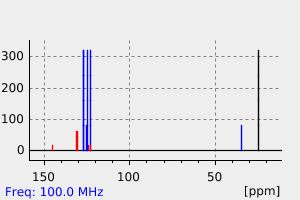2-isopropyl pyrene | 78751-61-8
中文名称
——
中文别名
——
英文名称
2-isopropyl pyrene
英文别名
2-isopropyl-pyrene;2-isopropylpyrene;Pyrene, 2-(1-methylethyl)-;2-propan-2-ylpyrene
CAS
78751-61-8
化学式
C19H16
mdl
——
分子量
244.336
InChiKey
MZHWYYWPJIVLRW-UHFFFAOYSA-N
BEILSTEIN
——
EINECS
——
-
物化性质
-
计算性质
-
ADMET
-
安全信息
-
SDS
-
制备方法与用途
-
上下游信息
-
文献信息
-
表征谱图
-
同类化合物
-
相关功能分类
-
相关结构分类
物化性质
-
沸点:396.7±9.0 °C(Predicted)
-
密度:1.152±0.06 g/cm3(Predicted)
计算性质
-
辛醇/水分配系数(LogP):6.2
-
重原子数:19
-
可旋转键数:1
-
环数:4.0
-
sp3杂化的碳原子比例:0.16
-
拓扑面积:0
-
氢给体数:0
-
氢受体数:0
上下游信息
-
下游产品
中文名称 英文名称 CAS号 化学式 分子量 2-乙酰基芘 2-acetylpyrene 789-06-0 C18H12O 244.293
反应信息
-
作为反应物:描述:参考文献:名称:Protonation and sulfinylation of isomeric isopropylpyrenes, 2,7-di-tert-butylpyrene, and tetracyclohexyl- and tetracyclopentylpyrenes: remarkably stable, sterically crowded pyrenium cations摘要:1-Isopropyl- (1), 2-isopropyl- (2), 4-isopropyl- (3), 1,3,6,8-tetraisopropyl- (4), and 1,3,5,7,9-pentaisopropylpyrene (5), 2,7-di-tert-butylpyrene (6), and 1,3,5,8-tetracyclohexyl- (7) and 2,4,7,9-tetracyclopentylpyrene (8) in FSO3H or CF3SO3H (TfOH) in SO2 or SO2ClF solvent gave stable monopyrenium ions. In agreement with theory, exclusive alpha protonation occurred at low temperature (-75 --> -65-degrees-C) irrespective of the position of the substituents. The position of alpha-protonation is controlled by inductive stabilization of the alkyl (cycloalkyl) groups. Unlike hexahydropyrene which is diprotonated in FSO3H.SbF5 (1:1) Magic acid, with isopropylpyrenes stable dications could not be generated; in SO2 solvent the Wheland intermediates of sulfinylation were observed, whereas in SO2ClF solvent oxidation and monoprotonation were competitive. Charge distribution patterns in the sulfinylation sigma-complexes are similar to those of protonated pyrenium ions. Stable pyrenium cations deprotonate or desulfinylate on quenching without dealkylation or disproportionation. At higher temperatures (ca. -40-degrees-C), ipso-protonated 4 undergoes isomerization in FSO3H/SO2 solvent; other alkyl (cycloalkyl)pyrenium cations show no isomerization/disproportionation. Upon standing in Magic Acid, hexahydropyrene is oxidized to pyrene.DOI:10.1021/jo00024a018
-
作为产物:描述:4,5,9,10-四氢芘 在 aluminum (III) chloride 、 2,3-二氯-5,6-二氰基-1,4-苯醌 作用下, 以 四氢呋喃 、 二硫化碳 为溶剂, 反应 87.0h, 生成 2-isopropyl pyrene参考文献:名称:2-取代pyr衍生支架的合成与结构摘要:y具有形成荧光准分子的倾向,因此这种发色团通常存在于传感器和荧光探针中。2-官能化pyr特别令人感兴趣,但是这些支架的制备并非易事,涉及需要4,5,9,10-四氢py作为关键中间体的合成途径。在此,描述了开发和优化合成2-官能化的-衍生结构单元的途径的方法,该方法具有用作制备荧光探针的标签的潜力。另外,4,5,9,10-四氢-2-py-5-氧戊酸乙酯和2-乙酰基-4,5,9,10-四氢py乙酯的晶体结构揭示了饱和的四氢py环的独特构象。DOI:10.1016/j.tetlet.2017.10.058
文献信息
-
METHOD FOR PRODUCING ARENE COMPOUNDS AND ARENE COMPOUNDS PRODUCED BY THE SAME申请人:JSI Silicone Co.公开号:US20210188739A1公开(公告)日:2021-06-24Provided is a method for producing (alkyl)arene compounds represented by Formulae 3-1, 3-2, and 3-3 by the Friedel-Crafts alkylation reaction of alkyl halide compounds and arene compounds using organic phosphine compounds as a catalyst.
-
一种铁催化苄位叔碳断键氧化合成芳酮的方法
-
Berg, Arne; Lam, Joergen; Hansen, Poul Erik, Acta chemica Scandinavica. Series B: Organic chemistry and biochemistry, 1986, vol. 40, # 8, p. 665 - 677作者:Berg, Arne、Lam, Joergen、Hansen, Poul ErikDOI:——日期:——
-
Nitration of isopropylpyrenes. Strained models for protonation and transfer-nitration in the condensed phase作者:Kenneth Khosrow Laali、Tze Ming Liang、Poul Erik HansenDOI:10.1021/jo00035a022日期:1992.4Protic mono- and dinitration of 1,3,5,7,9-pentaisopropylpyrene (1) occurred at the available alpha positions to give 2 and 3. Despite steric crowding, 2 and 3 did not exhibit a torsional barrier to i-Pr rotation at ambient temperatures; however, buttressing of the peri i-Pr groups was evident (H-1 NMR, UV, and force field energy minimizations). Persistent (dihydroxyiminium)pyrenium dications 2a+2 and 3a+2 were formed by low temperature protonation of 2 and 3 with CF3SO3H (TfOH)/SO2 or with FSO3H/SO2. Intramolecular cyclization of the nitro group of 2a+2 gave the rearranged pyrenium ion 2c+. 1 reacted with NO2+BF4- in acetonitrile solvent to give two pyrenium ions stable at rt, viz. the Wheland intermediate of alpha-nitration 2b+2 and the (dihydroxyiminium)pyrenium dication 2a+2; the latter was also the predominant pyrenium ion formed in the reaction of 1 with NO+BF4- in acetonitrile. Reaction of 1 with NO2+BF4- in chloroform solvent gave alpha-nitration products and a persistent radical cation RC. The simultaneous presence of alpha-nitration products and a persistent pyrenium RC was also observed in the reaction of 1 with NO+BF4- in chloroform, where broader NMR line widths and a stronger ESR signal suggested more extensive oxidation. Protic and aprotic nitrations of 1,3,6,8-tetraisopropylpyrene (10) occurred at the alpha-beta positions; a minor addition product (26) was also found. A mixture of isomeric dinitropyrenes was obtained in NO2+ nitration of 1-isopropylpyrene (13). In line with low temperature protonation studies, aprotic nitrations of 2-isopropyl- and 4-isopropylpyrenes occurred predominantly at the alpha positions. The crowded pyrenium ion of 3 and 2 transfer nitrate to aromatics (toluene, mesitylene, benzene) under mild conditions in competition with a more facile transalkylation.
-
BERG A.; LAM J.; HANSEN P. E., ACTA CHEM. SCAND., 40,(1986) N 8, 665-677作者:BERG A.、 LAM J.、 HANSEN P. E.DOI:——日期:——
表征谱图
-
氢谱1HNMR
-
质谱MS
-
碳谱13CNMR
-
红外IR
-
拉曼Raman
-
峰位数据
-
峰位匹配
-
表征信息
同类化合物
顺式-1,2-二(1-芘基)环丁烷
顺式-1,2-二(1-芘基)环丁烷
顺式-(-)-苯并(a)芘-7,8-二醇-9,10-环氧化物
雄甾烷
还原黑29
还原黄4
还原金橙G
还原绿2
还原绿1
还原紫3B
还原紫 10
还原深蓝BO
还原橙4
还原橙2
还原兰黑BBN
还原亮橙IRK
试剂N1,N1,N3,N3,N6,N6,N8,N8-Octakis(4-methoxyphenyl)-1,3,6,8-pyrenetetramine
蒽酮紫79
蒽缔蒽酮
蒽并(1,2,3,4-ghi)苝
蒽嵌蒽
蒽[9,1,2-cde]苯并[rst]戊芬
萘并[2'.8',2.4]晕苯
萘并[2',1',8',7':4,10,5]蒽并[1,9,8-abcd]晕苯
萘并[1,8-gh:4,5-g'h']二喹啉
萘并(8,1,2-bcd)苝
萘并(2,3-a)晕苯
萘并(2,1,8-qra)萘并萘-7 12-二酮
萘并(1,2,3-mno)醋菲烯
萘[2,3-a]芘
菲并[1,10,9,8-opqra]苝
茚并(1,2,3-cd)芘
苯胺,2-氯-3-(苯基甲氧基)-
苯并[xyz]庚芬
苯并[wx]萘并[2,1,8,7-hijk]庚省
苯并[rst]菲并[1,10,9-cde]戊芬
苯并[rst]戊酚-5-甲醛
苯并[pqr]四苯-5-基甲酸根
苯并[pqr]四苯-11-基甲酸根
苯并[pqr]二萘并[8,1,2-bcd:2',1',8'-lmn]苝
苯并[p]萘并[1,8,7-ghi]屈
苯并[l]芘-8-醇
苯并[ghi]苝
苯并[e]芘
苯并[b]芘-6-基甲醇
苯并[b]芘-6,12-二酮
苯并[b]芘-3,6-二酮
苯并[b]芘-1,6-二酮
苯并[a]芘-9,10-环氧化物
苯并[a]芘-7-醇







